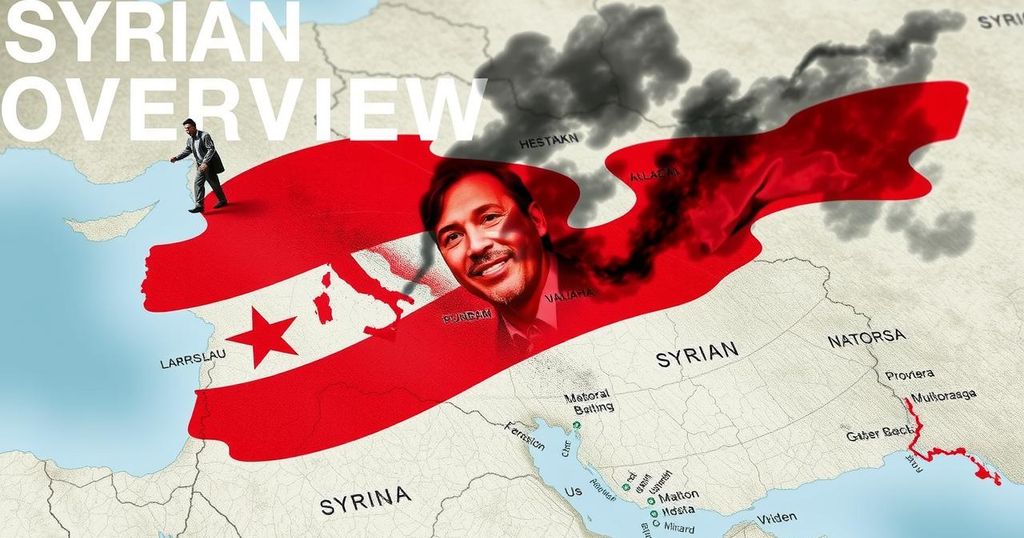The Fall of Assad: A New Era for Syria After Decades of Authoritarian Rule
The Assad regime, which ruled Syria for decades, has collapsed following a successful offensive by Hayat Tahrir al Sham (HTS), leading to celebrations across Syria and the world. Hafez al-Assad established a repressive regime in 1971, which continued under his son Bashar. The Syrian conflict, initially sparked by the 2011 protests, escalated into a civil war dominated by outside forces. HTS, now a significant power in the region, has emerged with nationalist goals. The implications for regional geopolitics will be extensive as competing interests realign post-Assad.
Recent events have marked a significant turning point in Syria’s history, culminating in the fall of the Assad regime after over fifty years of authoritarian rule. Bashar al-Assad fled to Russia following a sudden offensive launched by Hayat Tahrir al Sham (HTS), an Islamist group, which culminated in the capture of Damascus. This development reignited the ongoing civil war that initially began in 2011 when protests arose against Assad’s iron-fisted rule. Once HTS took control of the capital, jubilant celebrations erupted across Syria and in various cities worldwide, as people celebrated the collapse of an authoritarian regime long characterized by violence and oppression.
The Assad regime, led initially by Hafez al-Assad beginning in 1971, was notorious for its oppressive tactics and corruption. Hafez’s approach combined elements of state capitalism with a reliance on military and paramilitary control, particularly after the 1967 war with Israel and the subsequent Syrian civil unrest. Following his death, Bashar al-Assad continued his father’s policies, exacerbating divisions within society and implementing economic changes that favored a wealthy elite, often at the expense of the working class.
The 2011 revolution in Syria ignited following similar uprisings in the region, where initial calls for democratic reforms quickly transformed into widespread protests met with violence. Bashar al-Assad responded with extreme force, encouraging sectarian divisions and utilizing military power against civilians. With the emergence of the Free Syrian Army and external interventions by various foreign powers, the conflict escalated into a full-blown civil war that has persisted for over a decade.
HTS, initially formed as Jabhat al-Nusra, rose to prominence amidst the chaos. Despite its origins linked with al-Qaeda, it has since distanced itself from global jihadist agendas, seeking control over Syria instead. Led by Abu Mohammed al-Jolani, HTS emerged as a significant player in the northern regions, establishing governance while facing local dissent against its strict rule. Despite its controversial reputation, HTS has now positioned itself as a key force in the aftermath of Assad’s regime’s collapse.
The fall of Assad has grave implications for international relations and geopolitics in the region. Iran, a primary backer of Assad, has begun to distance itself from the now-defunct regime while Russia continues to offer protection to Assad in exile. The dynamics of power have shifted, with competing factions, including Turkey and Kurdish forces, considering their next steps amidst the new political landscape. Additionally, the fate of the Kurdish community remains precarious as they navigate alliances and the shifting political environment following HTS’s rise.
In summary, the rapid developments in Syria reflect a culmination of discontent against decades of repressive governance under the Assad regime, leading to its eventual downfall amid a deeply fragmented civil war. As the situation evolves, HTS’s role and the impending shifts in various regional powers will significantly determine Syria’s future trajectory, calling into question how different communities will assert their rights in the new political context.
“It is the Syrian people who must decide on the future of their country and its political and governmental system.” – Masoud Pezeshkian
The fate of Syria remains uncertain, with the potential for continued conflict amid competing interests and the need for a renewed focus on the voice of the Syrian populace regarding their governance. Furthermore, the impact on Kurdish autonomy and the geopolitical landscape involving Israel and its neighboring territories will require careful consideration and strategic navigation by all involved parties. In light of the ongoing struggle, the voice of everyday Syrians and protection of their rights must remain at the forefront as they seek to reshape their future.
The situation in Syria has evolved dramatically over recent decades, with an authoritarian regime led by the Assad family dominating political life since 1971. The uprisings in 2011 commenced against a backdrop of widespread repression and economic grievances, part of the larger Arab Spring movement. The subsequent civil war saw a complex interplay of local, national, and international powers, leading to a protracted humanitarian crisis. The recent overthrow of Assad highlights the long-standing frustrations with a regime that stifled dissent and fostered division within society.
In conclusion, the fall of the Assad regime marks a pivotal moment in Syria’s ongoing struggle for democracy and human rights. The chaotic aftermath presents both challenges and opportunities for the formation of a new government that responds to the aspirations of all Syrians. As regional powers and factions reposition themselves in this new landscape, the need to prioritize the voices and rights of the Syrian people remains crucial to ensuring a stable and just future for the nation.
Original Source: socialistworker.co.uk




Post Comment